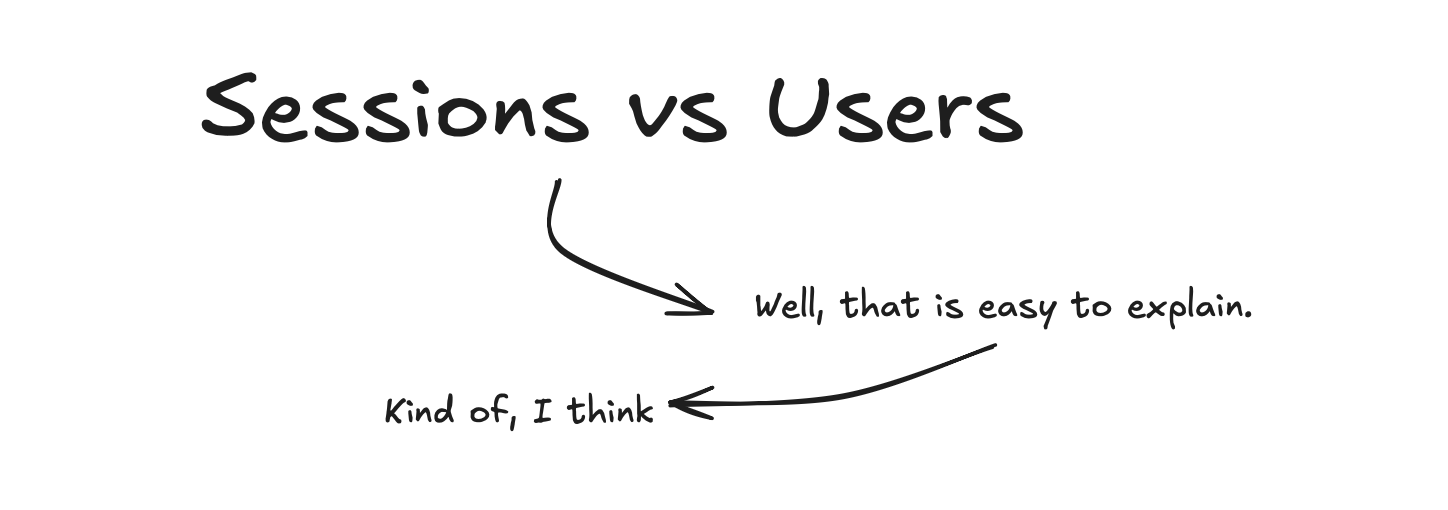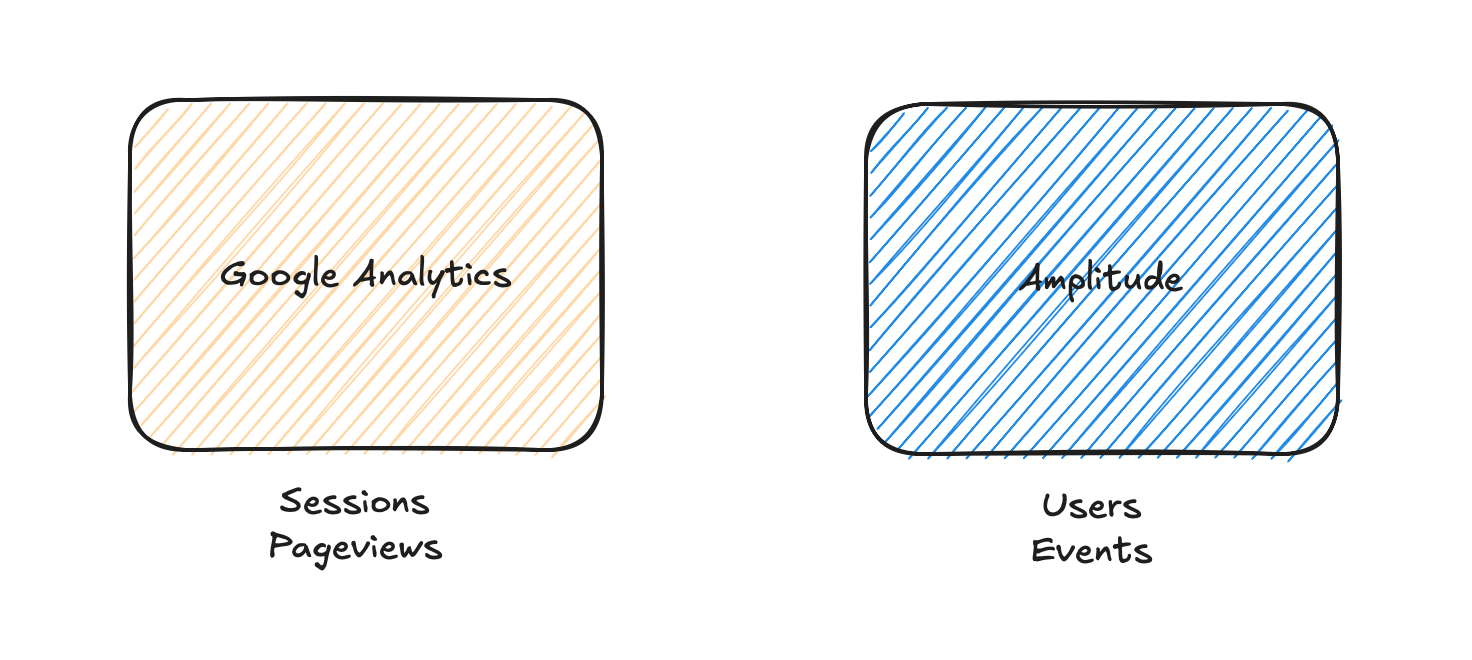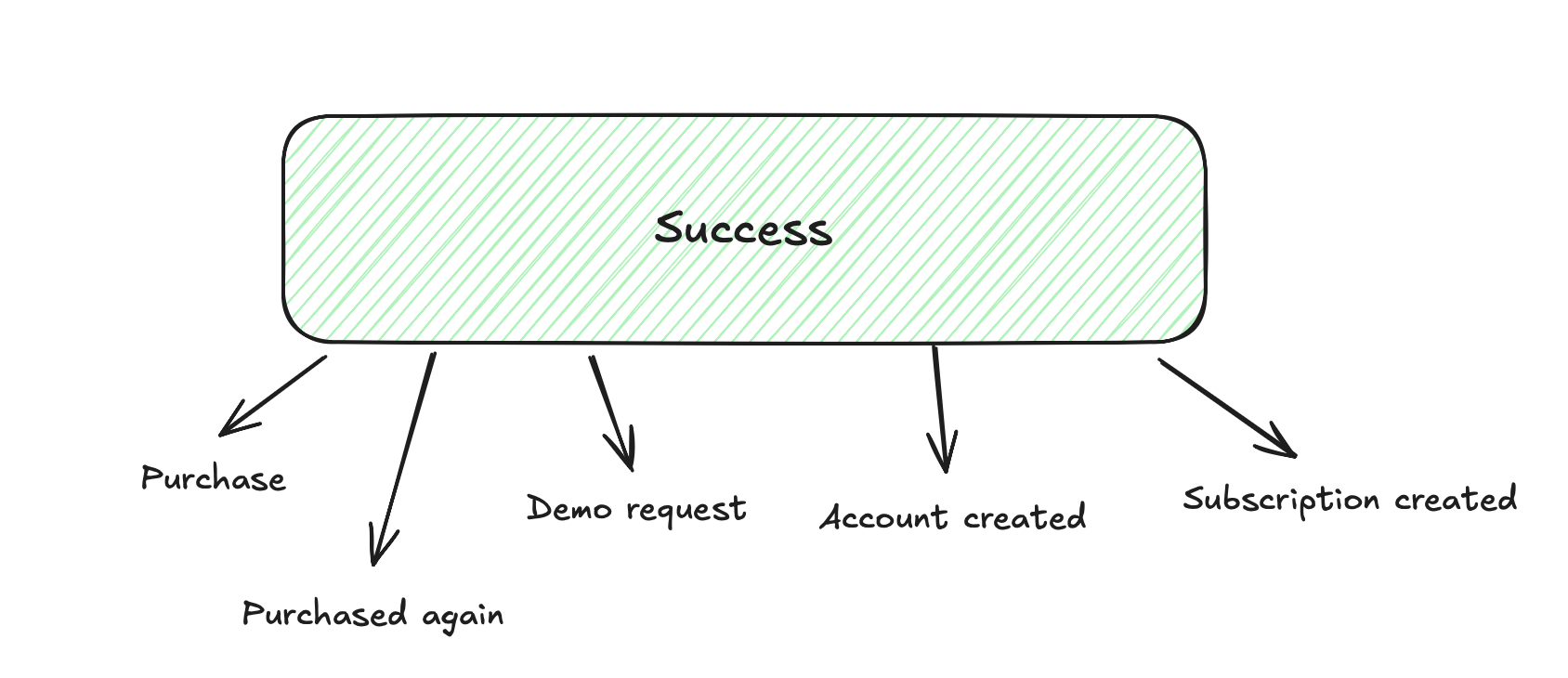Sessions v Users
So here's a small story about making things easy.

The other day I tried to make what I thought would be a simple video about sessions versus users in analytics. You know, just explaining when to use each one and if one's better than the other. I figured it would be easy - no notes needed, just me and my whiteboard. Well, I was wrong. Three times wrong, actually.
Thanks for reading Hipster Data Lab! Subscribe for free to receive new posts and support my work.
Each time I started explaining, I'd get partway through and realize "Nope, this makes no sense" and have to start over. Pretty frustrating!
What makes this whole thing interesting is why I was even making this video. In my workshops, I keep getting this question that I thought wasn't really relevant anymore: "How do we compare sessions versus users?" It usually comes from people who've used Google Analytics forever and are switching to tools like Amplitude, which are all about tracking users instead of sessions. Here's the twist - even Google Analytics 4 is mostly about users now. They actually removed a bunch of session metrics when they launched it. People weren't happy about that, so they had to bring some of them back.

I'll be honest - I moved away from Google Analytics years ago to more user-focused tools, and I work mostly in product analytics where it's all about the user journey. So I got pretty dismissive about sessions. When people in workshops would ask, "When should we use sessions?" I'd just say "Oh, sessions are complicated - better to avoid them if you can." But then they pushed back: "Look, we've been reporting on sessions forever. We can't just change everything without explaining why. We need to understand this properly."
And that's when it hit me - one of those moments in my data career where I realized I was taking the easy way out instead of really diving into the problem. That's what led to this whole thing - me trying (and finally succeeding!) to properly explain the difference between sessions and users.
Let me tell you what I figured out...
We need to talk about success first
We need to talk about what success means for your business before we get into sessions and users. I know it might seem obvious, but trust me, this matters.

Think about your website or app. Maybe it's just one small part of what your company does, or maybe it's the whole show. Either way, you need to know what "winning" looks like online.
Take some common examples:
If you're running an online store, success is pretty clear - someone buys something. For a SaaS company, it might be getting people to sign up for a demo, or create an account, or even better, start a subscription. And if you've got a big corporate website, maybe success is having people check out your products or apply for jobs.
Whatever it is, you need to know what counts as a win. (If you don't know this yet, that's your homework - figure out why you have a website in the first place!)
This matters for our sessions versus users discussion because both sessions and users can be "successful." And to really understand the difference between them, we need to look at these success moments. I'm going to use these successful events as our guide to explain how sessions and users work.
A successful session
Before we talk about successful sessions, let's break down what a session really is. I find it helps to use a real-world example.
Think about going to a supermarket. You walk in through the front door - boom, that's when your "supermarket session" starts. You walk around, grab what you need, maybe find some stuff you weren't looking for, check out, and leave. Session over.
But wait - you get to your car and realize you forgot milk. You go back in - and technically, that's a new session. Simple enough in the real world, right?
Online it gets trickier because we don't have actual doors. So we need to create rules about what counts as a session. Let's say someone visits your online store - how do we know if it's a new session or part of their last visit from 5 minutes ago?

Most analytics tools solve this with time. They look for gaps in activity. If someone's clicking around your site and there's less than 30 minutes between clicks, it's usually counted as one session. But if they leave for an hour and come back? New session.
Here's the important bit: a session is just a model we made up. Different tools might define it differently. The old Google Analytics even started a new session if someone came back through a different marketing link, or if it hit midnight. They did this to make their marketing reports work better.
Now, what makes a session successful? In an online store, the simple answer would be "someone bought something." We use this to calculate conversion rates.
But there's a catch - not everyone who visits your site is ready to buy. That's why conversion rates aren't usually 70-80%. Not every visit is a shopping visit.
We could get fancy and split this up better. Maybe we could separate "shopping sessions" (when someone adds stuff to their cart) from "browsing sessions" (when they're just looking around). Then we could measure success differently for each type.
Session metrics help us with two main things:
- Did the customer have a good experience?
- Which marketing source brought them in?
But remember - sessions only show us a small piece of the picture. People often visit multiple times before buying something. To understand the whole story, we need to look at user-based metrics too.
Thanks for reading Hipster Data Lab! Subscribe for free to receive new posts and support my work.
A successful user aka customer
Let's talk about two ways to track users online.
The basic way is using cookies or device IDs. It works, but it's not great - people clear their cookies, use different devices, or share devices. Maybe your teenager borrows your iPad, or you check the store from both your phone and laptop. Suddenly the data shows two or three "users" when it's just you. You end up with messy data.
The better way? Track actual user accounts. In an online store, this happens when someone orders something and creates an account. Now we can see everything they do as one customer, not random separate visits. If they browse on their phone during lunch break and finish the purchase on their laptop at home - we know it's the same person.
Now, what makes a user successful? Let's call them customers because that's what they really are in an online store. Unlike sessions (where success is pretty simple - did they buy something?), customer success is trickier.
Sure, getting someone to buy for the first time is great. But no online store can survive on just new customers. Think about your favorite stores - you probably buy from them regularly, right? That's what every store wants. We need more than just that first purchase.

What we really want is for customers to stick around and spend more over time. We want them to come back again and again. Think about it as different levels:
Level 1: New Customer
- They buy something for the first time
- Great start, but just the beginning
- Maybe they're testing us out with a small purchase
- We need to prove ourselves here
Level 2: Returning Customer
- They come back for second, third, fourth orders
- Shows they like what we're selling
- Starting to build a habit
- They trust us enough to come back
- Usually spend more than first-time buyers
Level 3: VIP Customer
- Maybe they've spent $2,000 in the last six months
- These are our rock stars
- They keep buying even when we don't advertise
- They tell their friends about us
- They're the backbone of our business
- Might be only 20% of customers but could make up 80% of sales
- When they do leave, it hurts more
So measuring customer success is way more complex than sessions. I always suggest at least splitting it into two parts:
- How good are we at getting new customers?
- How good are we at turning them into returning customers?
You could add more levels too - VIP conversions, different customer segments, whatever makes sense for your business. Maybe you have "bronze," "silver," and "gold" customers. Or maybe you split them by what they buy - fashion buyers versus home decor buyers. The key is looking at each group separately because they're totally different situations.
And here's the really interesting part - these different levels need different approaches. Getting someone to make their first purchase might need big discounts or ads. But turning them into a regular customer? That's more about good service, quality products, and maybe a loyalty program. And keeping your VIPs happy? That might mean special treatment, early access to sales, or personal shopping assistance.
This is why user-based analytics gives us a much richer picture than just looking at sessions. It helps us understand the whole customer journey, not just single visits.
So what is better now: Sessions or Users?
After all this, you can probably guess the answer - neither is better. They're just different ways of looking at your data. Let me break this down.
Session Metrics: Website Performance
Sessions tell us how well our website converts visitors right now. Remember though, it's just a model - don't read too much into it unless you've really fine-tuned how you track sessions.
Want to make session tracking more meaningful? In an online store, you might only count sessions when someone starts checking out. That makes sense, right? They're showing clear buying intent, so now we can really see if our checkout process works.
Session metrics are great for things like:
- How many visits we get
- How many of those turn into sales
- What our conversion rate looks like
- Running A/B tests to improve conversion
One really useful thing here is funnel analysis - tracking how many people move from viewing a product, to adding it to cart, to actually buying it. Sessions help us spot where people drop off.
User (Customer) Metrics: Business Health
Now this is where it gets interesting. If you really want to know how healthy your business is, you need to look at customer metrics. They tell you:
- How good you are at getting new customers
- How well you turn them into repeat buyers
- How many become VIP customers
- How well you keep those VIPs around
Here's a trap to watch out for: Your total revenue might look great, but what if it's all from existing customers? Maybe you're terrible at getting new ones. You'd never spot this just looking at session data - you need customer metrics.
Quick tip: Unless your site requires an account for everything, get your customer data from your backend systems (like order history) rather than frontend tracking.
Different Tools for Different Jobs
It all comes back to how you define success. For an online store, maybe it's just purchases. For a SaaS company, success might mean:
- Getting someone to book a demo
- Having them create an account
- Starting a subscription
Sessions help track one-time wins - like someone requesting a demo. User metrics show the bigger journey - from trying a demo, to creating an account, to becoming a subscriber.
The Real Answer
Use both! They show different parts of your business performance. The trick is knowing when to use which one and being able to explain to stakeholders what they're actually looking at.
Think of it like this: Sessions are like looking at today's weather, while user metrics are like looking at the climate. You need both to get the full picture.
Still have questions? Drop them in the comments - I'd love to help explain more!
If you like to watch my whole case, I have also recorded a video about it:
Thanks for reading Hipster Data Lab! Subscribe for free to receive new posts and support my work.
Join the newsletter
Get bi-weekly insights on analytics, event data, and metric frameworks.